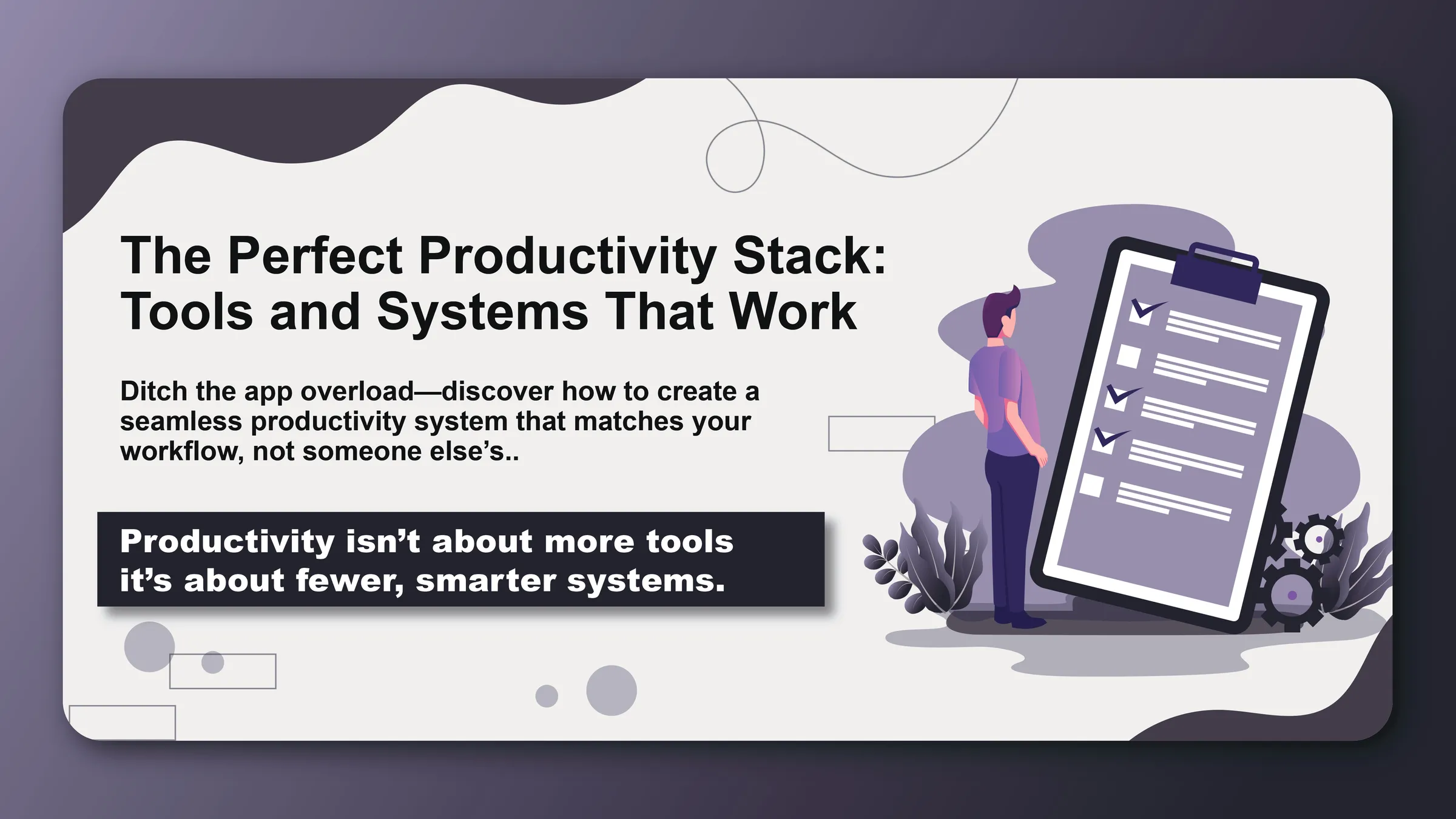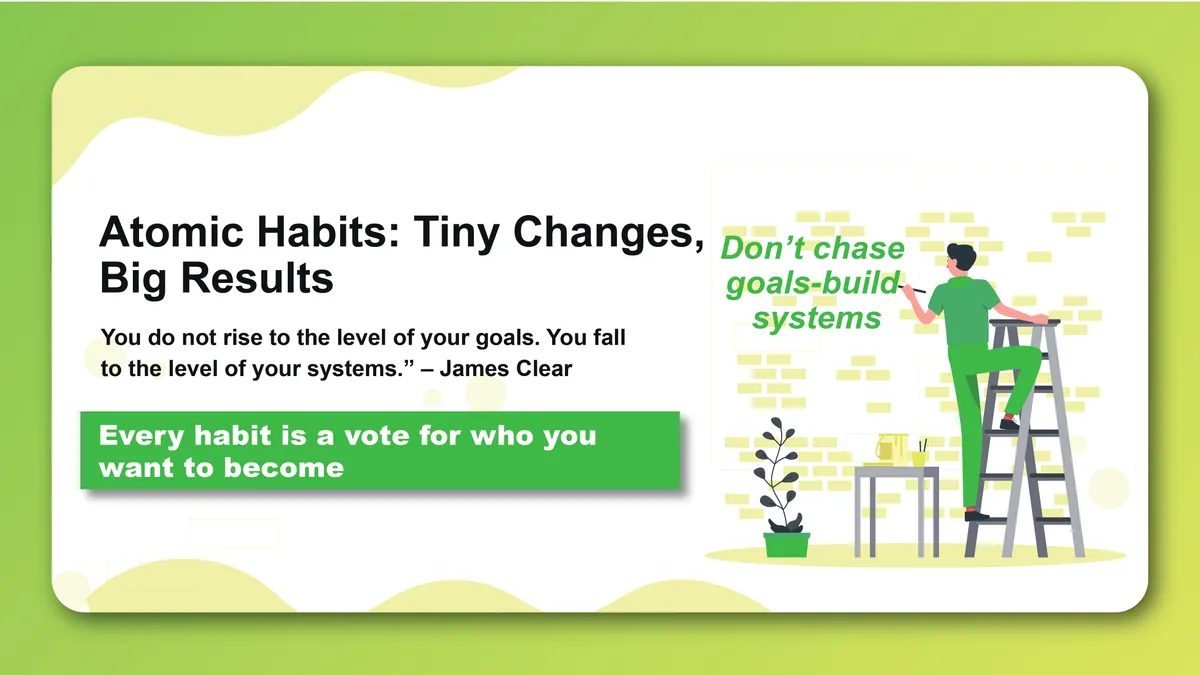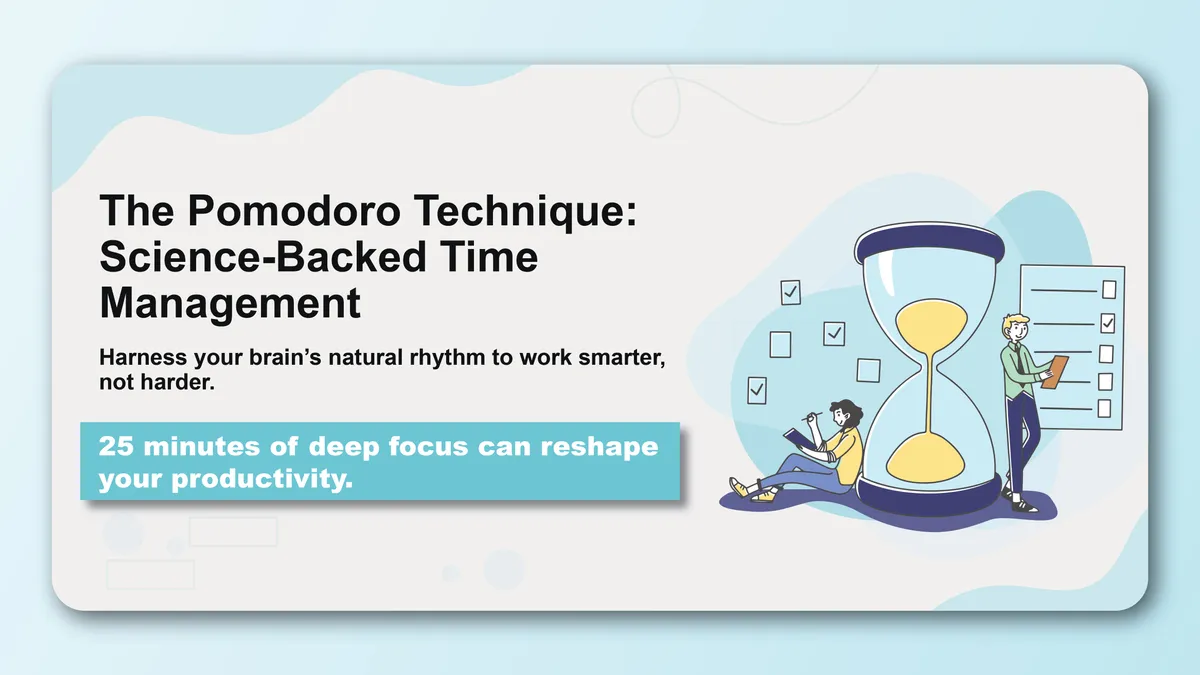Walk into any modern office and you'll see people juggling dozens of apps, switching between platforms, and struggling to keep track of information scattered across multiple systems. The average knowledge worker uses 87 different apps weekly, spending 21% of their time just searching for information.
The promise of productivity tools is alluring: better organization, increased efficiency, seamless collaboration. But the reality is often more complex. Too many tools can create more problems than they solve. The key isn't finding the perfect app—it's building a perfect system.
Your productivity stack isn't just a collection of tools. It's an interconnected system that supports your work, amplifies your strengths, and eliminates friction from your most important activities. When designed thoughtfully, it becomes nearly invisible—a seamless extension of your thinking and working process.
But building this system requires more than downloading the latest productivity app. It requires understanding how you actually work, what outcomes you need to achieve, and how different tools can work together to create something greater than the sum of their parts.
Understanding Your Productivity Needs
The Four Pillars of Productivity
Capture: Getting information out of your head and into a trusted system Organize: Structuring information so you can find and use it when needed Process: Converting information into actionable tasks and decisions Execute: Actually doing the work and tracking progress
Your Productivity Profile
Work Style Assessment
- Do you prefer visual or text-based interfaces?
- Are you a planner or do you work more spontaneously?
- Do you need detailed tracking or high-level overviews?
- Are you more motivated by deadlines or by progress?
Workflow Analysis
- What types of work do you do most often?
- Where do you encounter the most friction?
- Which activities take up the most time?
- What causes you the most stress or confusion?
Integration Requirements
- What tools are you required to use?
- Who do you need to collaborate with?
- What devices do you work on?
- What security or privacy requirements do you have?
The Anatomy of an Effective Productivity Stack
Core Components
1. Central Command Center Your primary dashboard where you see your most important information at a glance. This might be a task manager, calendar, or integrated workspace.
2. Capture Systems Quick, friction-free ways to get information into your system:
- Physical notebook for immediate capture
- Voice recorder for ideas while walking
- Email-to-task integration
- Mobile app for on-the-go entries
3. Organization Framework The structure that makes information findable:
- Consistent naming conventions
- Clear folder hierarchies
- Effective tagging systems
- Regular review processes
4. Processing Workflows Systems for converting raw information into actionable items:
- Inbox processing routines
- Decision-making frameworks
- Priority-setting methods
- Time-blocking procedures
5. Execution Tools What you use to actually do the work:
- Writing and editing software
- Communication platforms
- Creative tools
- Analysis and reporting systems
Integration Principles
Single Source of Truth Each type of information should live in one primary location. You should never wonder "Where did I put that?" because there's only one logical place for each item.
Seamless Data Flow Information should move smoothly between tools without manual copying or reformatting. Use APIs, automation, and integration tools to connect your systems.
Minimal Context Switching Reduce the mental cost of switching between tools by grouping related activities and using tools that work well together.
Backup and Recovery Ensure you can recover your information if any tool fails or if you decide to switch platforms.
Building Your Stack: A Step-by-Step Approach
Phase 1: Assessment and Planning
Current State Analysis
- List all tools you currently use
- Track how much time you spend in each tool
- Identify pain points and friction areas
- Note integration gaps and workarounds
Requirements Gathering
- What outcomes do you need to achieve?
- What constraints do you face?
- What preferences do you have?
- What would success look like?
Stack Planning
- Choose your central command center
- Identify essential tool categories
- Plan integration points
- Set implementation timeline
Phase 2: Core Tool Selection
Task Management Choose based on your planning style:
- Linear thinkers: Todoist, Things, or OmniFocus
- Visual thinkers: Trello, Asana, or Notion
- Minimalists: Apple Reminders or Google Tasks
- Power users: Notion, Obsidian, or custom solutions
Calendar System Your calendar should integrate with your task manager:
- Google Calendar for Google workspace users
- Outlook for Microsoft users
- Apple Calendar for Apple ecosystem
- Calendly for scheduling automation
Note-Taking and Knowledge Management Choose based on your information style:
- Structured thinkers: Notion, Obsidian, or Roam Research
- Simple notetakers: Apple Notes, Google Keep, or Evernote
- Researchers: Zotero, DevonThink, or Logseq
- Visual learners: Milanote, Scapple, or MindMeister
Communication Hub Consolidate where possible:
- Email: One primary account with forwarding
- Messaging: Slack, Microsoft Teams, or similar
- Video calls: Zoom, Google Meet, or Teams
- Phone: VoIP integration when possible
Phase 3: Integration and Automation
Native Integrations Look for tools that work well together out of the box:
- Google Workspace ecosystem
- Microsoft 365 suite
- Apple productivity apps
- Notion workspace solutions
Third-Party Integration Tools
- Zapier: Connect almost any app to any other app
- IFTTT: Simple automation rules
- Microsoft Power Automate: Enterprise-grade automation
- Shortcuts (iOS): Native mobile automation
Custom Solutions
- API integrations for advanced users
- Browser extensions for web-based workflows
- Scripts for repetitive tasks
- Dashboard creation tools
Phase 4: Optimization and Refinement
Workflow Optimization
- Eliminate unnecessary steps
- Batch similar activities
- Create templates for common tasks
- Set up keyboard shortcuts
Performance Monitoring
- Track time spent in each tool
- Measure task completion rates
- Monitor stress and satisfaction levels
- Identify bottlenecks and friction points
Continuous Improvement
- Regular stack reviews and adjustments
- Stay informed about new tools and features
- Experiment with improvements
- Gather feedback from collaborators
Productivity Stack Patterns
The Minimalist Stack
Core Tools
- Task management: Things or Todoist
- Notes: Apple Notes or Obsidian
- Calendar: Native calendar app
- Communication: Email + one messaging app
Benefits
- Lower cognitive load
- Fewer integration issues
- Reduced subscription costs
- Easier to master
Best For
- Individual contributors
- Simple workflows
- People who prefer depth over breadth
The Integrated Suite
Core Tools
- Google Workspace (Gmail, Drive, Docs, Sheets, Calendar)
- Microsoft 365 (Outlook, OneDrive, Word, Excel, Teams)
- Apple ecosystem (Mail, Calendar, Notes, Pages)
Benefits
- Seamless integration
- Consistent interface
- Single login
- Comprehensive feature set
Best For
- Teams and organizations
- Users who prefer consistency
- People who need strong collaboration features
The Best-of-Breed Stack
Core Tools
- Task management: Notion or Obsidian
- Email: Gmail or Outlook
- Calendar: Google Calendar or Outlook
- Notes: Roam Research or Logseq
- Communication: Slack + Zoom
Benefits
- Optimized for specific use cases
- Advanced features
- Flexibility and customization
- Can evolve with changing needs
Best For
- Power users
- Complex workflows
- People who enjoy customization
The Hybrid Stack
Core Tools
- Primary suite (Google or Microsoft)
- Specialized tools for specific needs
- Integration tools to connect everything
Benefits
- Balance of integration and specialization
- Flexibility to optimize specific workflows
- Easier collaboration within teams
Best For
- Most knowledge workers
- Teams with diverse needs
- Organizations with existing infrastructure
Common Stack Building Mistakes
Mistake 1: Tool Collecting
The Problem: Adding new tools without removing old ones, creating a cluttered and confusing system.
The Solution:
- Follow the "one tool per function" rule
- Remove tools before adding new ones
- Regular stack audits and cleanups
- Focus on integration over accumulation
Mistake 2: Over-Engineering
The Problem: Creating overly complex systems that require more maintenance than they provide value.
The Solution:
- Start simple and add complexity gradually
- Focus on frequently used workflows
- Prioritize reliability over features
- Test thoroughly before full implementation
Mistake 3: Ignoring Integration
The Problem: Choosing tools that don't work well together, requiring manual copying and formatting.
The Solution:
- Plan integration points before choosing tools
- Test integration capabilities
- Use automation tools to connect systems
- Consider ecosystem compatibility
Mistake 4: Neglecting Maintenance
The Problem: Letting systems degrade over time without regular updates and optimization.
The Solution:
- Schedule regular system reviews
- Keep tools updated
- Clean up unused accounts and data
- Adjust workflows based on changing needs
Advanced Stack Strategies
The Command Line Approach
Core Tools
- Text-based task management (todo.txt, taskwarrior)
- Command-line note-taking (vim, emacs)
- Terminal-based calendar and email
- Scripts for automation
Benefits
- Lightning-fast operation
- Infinite customization
- No vendor lock-in
- Minimal resource usage
Best For
- Technical users
- People who prefer keyboard over mouse
- Users who value speed and efficiency
The No-Code Automation
Core Tools
- Notion or Airtable as database
- Zapier or Integromat for automation
- Form builders for data collection
- Dashboard tools for visualization
Benefits
- Custom workflows without programming
- Powerful automation capabilities
- Flexible data structures
- Visual workflow design
Best For
- Non-technical users who want advanced features
- Small teams with unique workflows
- People who enjoy building systems
The Mobile-First Stack
Core Tools
- Mobile-optimized task manager
- Voice-to-text capture
- Cloud-based file storage
- Touch-optimized interfaces
Benefits
- Always accessible
- Fast capture and processing
- Location-aware features
- Reduced desk dependence
Best For
- People who work on-the-go
- Field workers
- Users who prefer mobile interfaces
Measuring Stack Success
Quantitative Metrics
Efficiency Measures
- Time to complete common tasks
- Number of tool switches per day
- Information retrieval speed
- Task completion rates
System Health
- Uptime and reliability
- Data sync success rates
- Integration error rates
- System response times
Qualitative Indicators
User Experience
- Reduced stress and frustration
- Increased confidence in system
- Better work-life integration
- Improved collaboration
Productivity Outcomes
- Higher quality work output
- Faster project completion
- Better decision-making
- Increased creative output
Your Stack Building Action Plan
Week 1: Assessment
- Audit your current tools and workflows
- Identify your biggest pain points
- Define your requirements and constraints
- Choose your central command center
Week 2: Core Selection
- Choose your task management system
- Select your note-taking platform
- Optimize your calendar setup
- Streamline your communication tools
Week 3: Integration
- Connect your core tools
- Set up automation workflows
- Create templates and shortcuts
- Test your integrated system
Week 4: Optimization
- Refine your workflows
- Eliminate unnecessary tools
- Train team members if needed
- Plan for ongoing maintenance
The Future of Productivity Stacks
Emerging Trends
AI Integration
- Intelligent task prioritization
- Automated content generation
- Smart scheduling and optimization
- Predictive workflow suggestions
Voice-First Interfaces
- Voice-controlled task management
- Audio note-taking and transcription
- Hands-free workflow execution
- Natural language commands
Augmented Reality
- Spatial computing interfaces
- Context-aware information display
- Gesture-based control
- Immersive collaboration spaces
Evolution Strategies
Stay Adaptable
- Build flexible systems that can evolve
- Avoid vendor lock-in when possible
- Keep data portable and exportable
- Maintain core workflows independent of specific tools
Continuous Learning
- Stay informed about new tools and techniques
- Experiment with emerging technologies
- Learn from other users and communities
- Regularly reassess and optimize your stack
The perfect productivity stack isn't about having the most tools—it's about having the right tools working together seamlessly. When you build a system that matches your workflow, eliminates friction, and supports your goals, productivity becomes effortless.
Your stack should feel like a natural extension of your thinking, not a burden to maintain. Start with your core needs, build incrementally, and focus on integration and optimization. The investment in building a great productivity stack pays dividends in reduced stress, increased output, and better work-life integration.
Ready to build your perfect productivity stack? Design and optimize your productivity system with Habityzer and create a seamless workflow that supports your best work.



